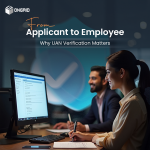Table of Contents
ToggleMaking the right hiring decisions is essential for the success of any business. However, even the best hiring decisions can turn sour if the background verification process is flawed. A thorough background check is an essential part of the hiring process as it helps safeguard your organization from various risks, including fraud, theft, and other security threats.
Despite the critical nature of background verification, many companies often overlook key elements or make errors during this process. These mistakes can lead to costly consequences down the road. Below, we explore nine of the most common mistakes made during background checks and how you can avoid them to ensure a secure and compliant hiring process.
1. Neglecting ID & Address Verification
Verifying a candidate’s identity and address is one of the most basic but crucial steps in the hiring process. Failing to complete these checks can make it difficult to trace the candidate in case legal or compliance issues arise in the future.
For example, imagine a situation where an employee leaves suddenly and takes a company-issued laptop containing sensitive data. Without a verified permanent address, tracing the individual becomes much more challenging. This can leave your organization vulnerable.
Solution:
Always include identity and address verification in your background check process. By confirming the candidate’s identity and permanent address, you create an essential safety net for your business in case of any issues down the road.
2. Skipping Criminal Record Checks (CCRV)
One of the most serious mistakes companies make is overlooking criminal record checks. This step is essential regardless of whether you’re hiring for white-collar roles or blue-collar positions. A criminal background check helps identify any past convictions or legal issues that could potentially put your organization at risk.
Failure to conduct this check could expose your organization to legal liability, reputational damage, or security threats.
Solution:
Make criminal background checks (CCRV) a mandatory part of your hiring process. Ensure that your checks are thorough, covering all national and international databases to spot any criminal history that may affect the safety and integrity of your business.
3. Inadequate Employment History Verification
It’s crucial to verify the employment history of every candidate you hire. Relying solely on a resume or trusting that the candidate’s claims are true without verification can lead to hiring underqualified or misrepresented candidates.
An employment history check (EHC) is simple, cost-effective, as it requires UAN and can uncover important information about the candidate’s previous roles and performance that might otherwise go unnoticed.
Solution:
Always perform a comprehensive employment history verification. Don’t limit this check to just one or two previous employers — verify all previous positions. This ensures that the candidate’s qualifications and experience are as represented.
4. Neglecting Education Verification
In today’s competitive job market, the temptation to embellish qualifications is high. Fake degrees, diplomas, and certifications are on the rise. Skipping education verification might allow these false claims to slip through the cracks.
Although education checks can sometimes take time, they are invaluable for confirming that your candidate has the credentials they claim to have.
Solution:
Always perform an education verification to ensure the authenticity of the candidate’s claimed degrees or certifications. While this may take some additional time, it’s well worth the investment to protect your business from hiring individuals with falsified educational backgrounds.
5. Overlooking Moonlighting Risks
Moonlighting, or working multiple jobs simultaneously, has become more prevalent in recent years. While it may seem harmless, moonlighting can indicate a lack of commitment or focus, particularly in roles requiring full-time attention and dedication.
In some cases, employees working multiple jobs could be dividing their time and attention between several responsibilities, which may affect their performance at your company.
Solution:
As part of your background check, assess whether candidates are engaged in multiple jobs. If moonlighting is a concern, especially in high-trust or high-responsibility roles, address it directly in the interview and check whether this is disclosed in their previous employment records.
6. Ignoring Professional Reference Checks
A professional reference check (PRC) provides valuable insights into the candidate’s previous work behavior, strengths, weaknesses, and overall character. This is an area often overlooked by companies, but it can provide key details that resumes or interviews can’t.
Without reference checks, you miss the opportunity to hear from previous managers or colleagues who can share honest feedback about how the candidate has performed in the past.
Solution:
Ensure you conduct a professional reference check for all candidates. This can help you gain deeper insights into how a candidate behaves in a work environment, their strengths, and their potential fit within your organizational culture.
7. Missing Global Background Checks
In today’s globalized world, many companies deal with international clients and remote teams across different countries. Some global clients may expect you to conduct credit checks (CREC) or global database checks (GDC) for employees, especially those who will be working on their projects.
Skipping these checks can lead to compliance issues and may damage client trust if your hiring process does not meet international standards.
Solution:
If you have global clients, make sure to include global checks for employees who will be working with them or handling sensitive data. Running global database checks and credit checks ensures you meet international compliance requirements and protect your reputation with clients.
8. Underestimating the Importance of Ongoing Monitoring
Background verification shouldn’t be a one-time activity. As your employees continue working with you, changes in their legal status, criminal background, or employment history might occur. Continuous monitoring ensures that you are aware of any new developments that could impact your employees’ status.
Without ongoing verification, you could miss critical updates such as newly filed criminal cases or revoked professional certifications, leaving your company exposed to unnecessary risks.
Solution:
Implement a system for continuous background monitoring that includes periodic re-verification of key factors such as criminal history, identity, and qualifications. This will help you keep your records current and avoid potential risks in the future.
9. Relying on Manual Processes
Manual background verification processes can be slow, inefficient, and prone to errors. Relying on human intervention to manually check and report background information can cause delays and inconsistencies in the hiring process.
Adopting an automated technology platform can streamline your background checks and eliminate manual errors, improving the speed and accuracy of your hiring process.
Solution:
Switch to a technology-first solution for background verification. By automating the process, you can ensure faster, more accurate checks and reduce the possibility of human error. Automated systems also help improve compliance, reporting, and scalability as your organization grows.
Conclusion
Effective background verification is essential for protecting your organization from the risks associated with hiring unqualified or potentially dangerous employees. Avoiding these common mistakes can help you build a more secure, efficient, and compliant hiring process.
By partnering with a trusted background verification service like OnGrid, you can streamline your hiring process, mitigate risks, and ensure that your candidates are thoroughly vetted, reducing the likelihood of costly mistakes. Take control of your hiring process today to safeguard your organization’s future.





Leave a Reply